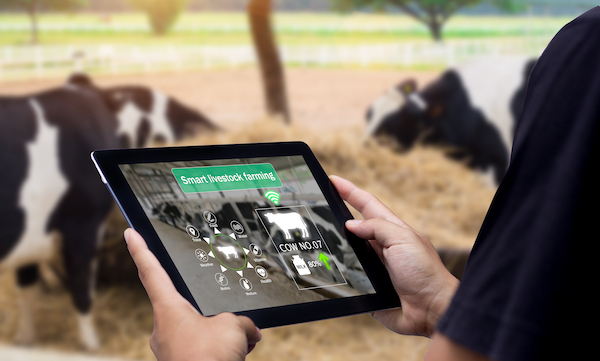Gone are the days when managing and monitoring livestock was entirely dependent on manual labor. Technological advancements have relieved the farmers from such physically demanding and time-consuming tasks. The farms and barns have transformed into modern spaces as they are now outfitted with high-end cameras, sensors, and computer systems.
Precision Livestock Farming (PLF) has reformed today’s modernized livestock industry by optimizing workflow, boosting efficiency, and ensuring quality. This mechanized farming practice facilitates the easier operation of critical day-to-day livestock tasks, including livestock monitoring, anomaly detection, and disease inspection.
Precision Livestock Farming makes sure that only the highest quality of dairy products and meat is distributed in the market. Since this method allows close, real-time scrutiny of the livestock, the rate of infected product that cause diseases is minimized.
Monitoring livestock to detect health problems at an earlier stage
As high-end machines entered into the world of dairy farming, farmers lost physical contact with their cattle — most of the processes, like milking, were automated. Consequently, the animals suffering from diseases and requiring special attention were left unattended, and therefore, their health problems escalated.
A group of Swedish farmers faced this issue when they were struggling to tackle a potentially fatal mammary gland infection known as Mastitis. The common symptom of Mastitis is inflammation, and this increases the temperature of the cow’s udder. The cure is simple — the infected cow is milked more often, and the farmers ensure no milk is left in the cow’s udder, as the remnant milk gives birth to harmful microorganisms.
That said, Mastitis is curable only when diagnosed at an early stage. As the milking process was mechanized, the farmers could not examine their cows’ udders for the abnormal temperature rise. This is where thermal imaging technology came to the rescue.
The thermal imaging systems were deployed to detect inflammation in the animals. These systems were potent enough to identify the disease in its initial stage, and that is how the lives of many domesticated cows were saved.
The thermal imaging system is also anticipated to offer inspection of livestock for other health conditions, such as nerve damage and skeletal problems, in the near future. The detection of diseases when they are in their initial phase — and still curable — minimizes veterinary costs and ensures healthy livestock.
Monitoring abnormal animal behaviors
The imaging systems are also efficient at inspecting domesticated animals for unusual behaviors. The monitoring of cattle for anomalous behaviors is crucial as it is often an indicator of the underlying low living standards, uncomfortable environment, or insufficient food or water. When the abnormal demeanor is brought to farmers’ notice, they address the problem and ascertain the cattle’s well-being.
The imaging systems are non-contact and cost-efficient machines that automatically monitor the livestock’s activities, including feeding, drinking, locomotion, and reproductive behaviors. Implicitly, these systems ensure the well-being of the cattle by highlighting their uncommon attitude.
In the past, such vision systems have been used to monitor specific animals like pigs. They are outfitted with surveillance cameras to detect anomalies and alert the farmers.
For successful anomaly detection, the imaging systems are first trained to understand the features of a contented animal. This enables them to alert the farmers when the animals behave otherwise. As a result, the underlying issue is resolved, and the health of the animal remains healthy.
Monitoring to offer optimum comfort
Ensuring all the necessary demands of the animals are fulfilled on time is crucial to improve the livestock’s health and welfare. The vision systems are also being used to ensure the cattle’s necessary demands, which are essential for its sustenance, are being met.
A classic example is an Irish startup company called Cainthus that developed a computer-vision system for dairy farmers. The system carefully examines the domesticated animals with the help of smart cameras and checks if they have any requirements, such as food or water. If there are any requirements, the farmers are informed via an app.
The vision system monitors the feeding activities and ensures the cattle are getting the right amount of feed at the right time. The advanced imaging system also checks if the fodder is accessible to the animals, apart from informing the farmers when it needs to be refilled.
Needless to say, the utilization of efficient imaging systems promotes the well-being of the livestock and ensures they remain free from infections and malnutrition. This, in turn, ensures that what they produce is healthy to consume or be used in the production of other products.
Let Universe Kogaku’s lens application engineers supply you with the best lens solution.
The monitoring of livestock is crucial to ensure they are free from fatal diseases and are healthy. The modern imaging systems facilitate easy cattle monitoring, offering relief to the farmers and maximizing their profit.
That said, the optimum functioning of the imaging systems is dependent on the quality of lenses they are equipped with. Universe Kogaku’s engineering team that can design and manufacture high-quality, precision lens assemblies. If you need premium custom lenses for your thermal imaging systems, please call 1-516-624-2444 or email info@universeoptics.com. One of our lens application engineers will get back to you as soon as possible.